Full-court embrace
How Flyers men's basketball turned tragedy into a drive to play for Dayton, achieving unprecedented success before COVID-19 cut short their season — but never their spirit. A look at an amazing year by the region's foremost sports reporter.
The Flyers men’s basketball season that reached unprecedented heights — bathed in a bright national spotlight and lovingly embraced locally — was bookended by so much fear and deadly consequence. It was the year of what could have been. Yet what the Flyers did accomplish, through hard work, teamwork and love, may be what long endures for the team and fans alike.

The Dayton Flyers’ 2019-20 season, which ended prematurely with the COVID-19 pandemic, had begun after a mass shooting in Dayton’s Oregon District that was witnessed by four UD players, all of whom are lucky to be alive.
That the Flyers still managed a season for the ages — one where they became the winningest, most enchanting, most talked-about team in UD history — had a lot to do with just the right timing.
Game after game — sometimes with no eye contact but almost always perfect timing — junior guard Jalen Crutcher would launch an alley-oop pass that a leaping redshirt sophomore forward Obi Toppin would grab above the rim and jam home for one of his UD-record 190 career dunks, many of which left a sold-out UD Arena crowd roaring in delight.
That the Flyers still managed a season for the ages had a lot to do with just the right timing.
And then there was the mid-January game against Saint Louis at Chaifetz Arena in Missouri when Crutcher brought the ball down court with six seconds left in overtime and the visiting Flyers trailing by one. He brushed his defender into a high screen set by Toppin, made a move to the left and hoisted a perfect 3-point shot for the win with just one second left.
That not only kept alive Dayton’s unbeaten streak that would reach a national-best 20 games, but it continued UD’s rise to a No. 3 ranking and kept the Flyers unscathed in what would end up as a perfect 18-0 record in Atlantic 10 play.
20 seconds
But the most crucial timing of the year came some three months before the first tip of the season — on the night of Aug. 3 — when some of the older players went to the Oregon District, a downtown dining and entertainment district.
Then, about an hour past midnight, a 24-year-old man from Bellbrook, Ohio, wearing body armor and firing a semi-automatic rifle burst out of a narrow walkway onto East Fifth Street next to Blind Bob’s bar.
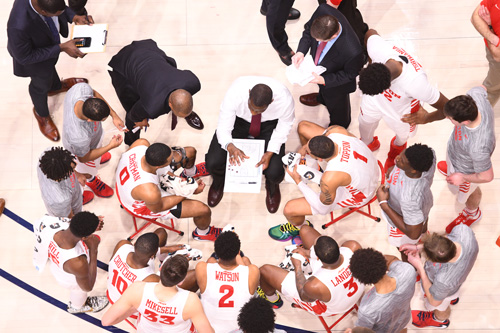 In just 32 seconds, he would kill nine people, injure 27 and terribly wound a city.
In just 32 seconds, he would kill nine people, injure 27 and terribly wound a city.
As the gunman was shooting his way across the street toward Ned Peppers bar, Trey Landers, the senior guard who had emerged as the emotional leader of the Flyers, ran inside the crowded bar, escaped out a back door and crawled over a high fence to safety.
An even more harrowing experience happened at the sidewalk taco stand in front of Blind Bob’s, where Ryan Mikesell, the Flyers’ other senior leader, and teammates Jhery Matos and Jordy Tshimanga had been waiting in a line to get something to eat.
According to Mikesell’s parents, Reed and Lisa, the trio had called an Uber to take them back to campus, but when the driver missed them, they took a few steps toward the car just as the killer stepped from the shadows and began firing, killing three people, including the gunman’s own sister, at that taco stand.
“Ryan said, ‘Mom, 20 seconds sooner and I’d have been the first one shot,’” Lisa Mikesell explained.
The three players pushed into the Uber, but the driver froze and they ended up watching the deadly rampage unfold until the police finally killed the shooter, who had hesitated a second before bursting through the front door of Ned Peppers.
“It was horrible,” Lisa Mikesell said.
The shaken players got back to campus and called head coach Anthony Grant ’87, who hurriedly assembled his team to make sure everyone was safe and to comfort them.
“It was hard to go back through it,” Landers said when asked about the experience later. “You can’t unsee some of the stuff I saw.”
Grant struck just the right tone and the team bond strengthened that night.
While Mikesell has never spoken publicly about the shootings, he has said Grant struck just the right tone and that the team bond strengthened that night.
Soon after, Grant got each of the players and coaches a pair of rubber bracelets. A red one bore the dates of the Oregon District shooting and the Memorial Day tornadoes that ravaged the Dayton area.
A white bracelet simply read “Dayton Strong” and the team, which wore those bands religiously from then on, brought that message to life more and more as the season progressed.
“Every single day we go out and play for everybody in Dayton and everybody watching,” Toppin said.
Crutcher agreed: “We knew we had to lift the community up with basketball. There was nothing else that could lift the community up like that because they love basketball here.”
Common thread
Overlooked in the preseason when they were picked to finish third in the A-10, the Flyers muscled themselves into the national conversation at Thanksgiving when they romped over Georgia and Virginia 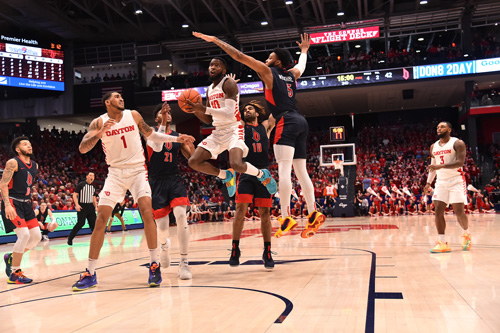 Tech at the Maui Invitational before falling in overtime to Kansas, the team that would end the season ranked No. 1.
Tech at the Maui Invitational before falling in overtime to Kansas, the team that would end the season ranked No. 1.
The Flyers would lose only once more — four days before Christmas — when they were edged by Colorado in overtime on a 3-pointer at the buzzer.
After that came the long winning streak and the cathartic relief for a hurting city.
As Dayton Mayor Nan Whaley, a 1998 UD alumna, put it, “We’re going to get through this winter with the Flyers. They have lifted everybody’s spirits and helped us come together. It’s given us something to celebrate.”
Landers, who grew up in Dayton and graduated from Wayne High School in nearby Huber Heights, Ohio, said people would stop him on the street and thank him for what the Flyers were doing for them.
And it was not just that the team was winning — their 29-2 record is the best in UD history — but how they did it.
They seemed to relish each other’s success. They shared the ball, passing up their own good shots for teammates with better shots, and that’s why Dayton ended the season with the best field goal percentage in college basketball — 52.5%.
“That shows a team where they’ve all bought in,” said legendary Flyers coach Don Donoher ’54, who was Grant’s coach at UD in the mid-1980s.
“They seem to have a little of Anthony in them.”
“As I watch them play, they seem to have a little of Anthony in them,” Donoher said. “They have his personality. He was a great teammate. He was selfless. He did all those intangible things that make a team better, and it’s like he’s imparted that to them.”
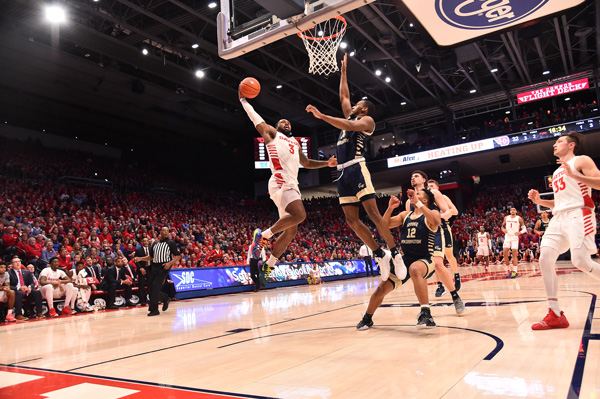 The Flyers bonded in part because many shared the common thread of being previously overlooked, undervalued or, at the very least, doubted by recent circumstance.
The Flyers bonded in part because many shared the common thread of being previously overlooked, undervalued or, at the very least, doubted by recent circumstance.
Toppin had no scholarship offers coming out of Ossining High in Westchester County, New York, ended up at a prep school and then came to UD where he had to sit out another year to meet NCAA academic standards.
Five other players joined the team after they had transferred. Mikesell underwent double hip surgery and missed his junior year, and Landers, whose father was murdered 14 years ago in what’s still an unsolved case, played in only nine games for a total of 52 minutes his freshman season on coach Archie Miller’s final UD team.
But the biggest slight involved Grant himself who, after great success at VCU, had been fired as the Alabama coach in March 2015, even though he’d had five winning seasons in six years.
“Anthony is strong in his convictions, and those convictions and the personnel he had down in Alabama didn’t mesh,” Donoher said. “He lost some key players along the way, but he is not going to sacrifice his principles.”
“He is not going to sacrifice his principles.”
Now just five years later, Grant has won five national coach of the year awards including the prestigious Naismith Award.
“It’s just an unbelievable story,” Donoher said proudly.
Toppin’s story was just as remarkable. His highlight-reel dunks, ability to run the floor, make pinpoint passes and knock down 3-point shots without hesitation were eclipsed only by the pure joy he showed with his teammates, the fans and even rival teams.
That made him the darling of college basketball, and he got almost everyone’s vote for college basketball’s national player of the year.
All of this whetted everyone’s appetite for the postseason. The Flyers were the top seed in the Atlantic 10 Tournament and were on track to become a No. 1 seed in the NCAA Tournament, something no team at UD had ever done.
And that’s when the season’s other bookend slammed up against their wondrous season.
Step up
No one knew what they were witnessing on Saturday night, March 7, as the Flyers closed out the regular season with a 76-51 victory over George Washington at UD Arena.
Most thought it was the beginning. Really it was the end.
It had been a full day of hoops celebration in which, as Grant put it, Dayton was “the epicenter of college basketball.”
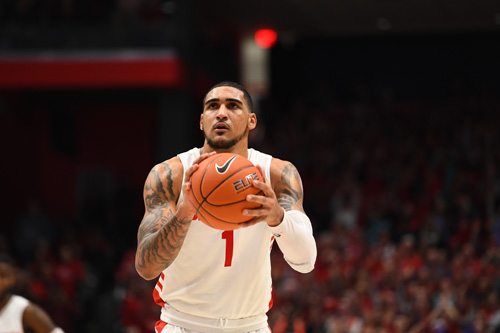 That morning, ESPN’s popular College GameDay show had broadcast from the Frericks Center on campus, the location of the beloved Fieldhouse where the Flyers played basketball before UD Arena was built and where volleyball reigns today. Thousands of people — some who’d camped out there overnight — stood in line to get in. They carried signs, cheered and took part in a social media celebration of all things Flyers.
That morning, ESPN’s popular College GameDay show had broadcast from the Frericks Center on campus, the location of the beloved Fieldhouse where the Flyers played basketball before UD Arena was built and where volleyball reigns today. Thousands of people — some who’d camped out there overnight — stood in line to get in. They carried signs, cheered and took part in a social media celebration of all things Flyers.
Then before the evening game, UD held its sentimental senior night festivities at midcourt for Mikesell and Landers and their families.
All the emotions of the day seemed to drain the Flyers, who then uncharacteristically struggled with GW before intermission.
But during a timeout early in the second half — with UD leading by just two points — the sold-out crowd was surprised when Jeremy Ganger, a bouncer at Ned Peppers the night of the mass shooting, strode to midcourt.
He had ushered many people — including UD students — to safety inside his bar that August night and then stood face-to-face with the shooter, a delay at the door that allowed police to kill the assailant.
Knowing that Ganger had saved many lives that night, UD President Eric Spina and athletics director Neil Sullivan wanted him to be honored at the Flyers’ final home game.
The crowd gave the 42-year-old Ganger, a compact, former Urbana University football player, a long standing ovation as the PA announcer saluted his “bravery and courage.”
And that’s when Ganger showed he was there to protect UD again. He raised his tattooed arms to the crowd and urged fans to cheer the Flyers, explaining later he wanted the team to “step it up.”
Amazingly, that’s just what happened.
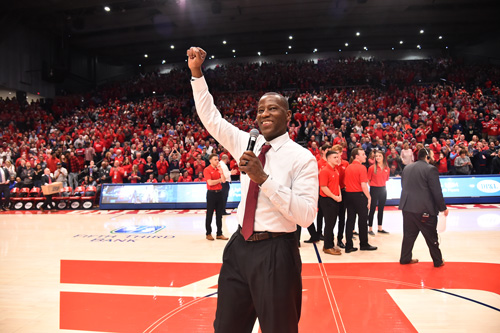 The Flyers went on a 23-4 run, much of it spurred by the aggressive play of Crutcher and several jaw-dropping dunks by Toppin, including one that came with a 360-degree spin and another where, in mid-leap, he twirled the ball around his right leg and then unleashed a massive tomahawk slam.
The Flyers went on a 23-4 run, much of it spurred by the aggressive play of Crutcher and several jaw-dropping dunks by Toppin, including one that came with a 360-degree spin and another where, in mid-leap, he twirled the ball around his right leg and then unleashed a massive tomahawk slam.
After the victory, family members of the team, fans, a collection of national media and several former players flooded the court for a net-cutting ceremony that soon was more of a lovefest.
Several players were in tears, knowing this not only was the last time Mikesell and Landers would be on Blackburn Court, but also, almost certainly, it was the end for Toppin, who would leave for the NBA draft after the season.
“Dayton was perfect for my boy,” Roni Toppin, Obi’s mom, said as she stood on the court. “He came here and accomplished all the goals he set out to.”
Several former players had come to UD Arena that night to be a part of “making history,” as Crutcher had called it. Many of them saluted Grant.
“He knows the tradition and what it means here.”
“It’s so beautiful to see a former player come back and really put UD on the map at the national level and gain the respect it deserves again,” said Derrick Dukes ’94, a guard from the early 1990s. “Anthony has worn the uniform. He knows the tradition and what it means here.”
The Rev. J.D. Grigsby ’73, who had played for Donoher, lauded the way Grant does his job.
“He’s a humble guy,” Grigsby said. “He has character and decency and he loves the kids. He teaches them his own way. He doesn’t have to do all that yelling and screaming. He coaches them with love.”
Standing off to the side with his family that night, Grant had marveled at the scene: “I looked up and it was an hour after the game and there were still 12,000 people there. Where else in the country are you going to get that? It was pretty cool!”
Grigsby — who had spent endless days helping tornado victims in nearby Trotwood, Ohio, and then counseled shooting victim families in the hours immediately after the Oregon District attack — watched the full-court embrace between the town and the team and said quietly, “Just look at this. This is beautiful. This is, as they say, ‘Dayton Strong.’”
‘Let us be thankful’
But as he stood in the middle of the UD Arena celebration, Grant also had a gnawing concern:
“To be honest, I was just hoping nobody would get sick. There already was some talk of how the virus was spreading, and I just looked out there and thought, ‘Oh, man, there are maybe 1,000 people out there on the court.”
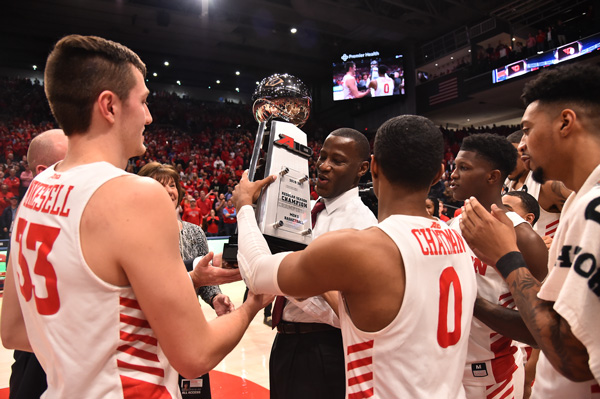 When the team flew out to the A-10 Tournament in Brooklyn a few days later, he said one player did remain home with the flu.
When the team flew out to the A-10 Tournament in Brooklyn a few days later, he said one player did remain home with the flu.
“It wasn’t COVID-19, but you saw how quickly something can spread,” he said.
Not long after the team got to New York, Utah Jazz center Rudy Gobert tested positive for the novel coronavirus, which causes COVID-19, and that night the NBA abruptly suspended its season.
Dominoes fell quickly in the sports world after that. The A-10 first announced no fans would be allowed into the Barclays Center for games, and then came word the tournament was canceled.
As the dejected team flew home, players learned through social media that the entire NCAA Tournament had been canceled, too.
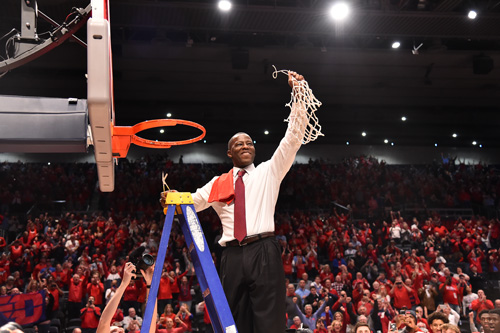 Crutcher — who in the euphoria after the GW game had said, “I feel we are going to win a national championship” — was shaken when he got back to Dayton:
Crutcher — who in the euphoria after the GW game had said, “I feel we are going to win a national championship” — was shaken when he got back to Dayton:
“We’re all upset because we knew we were going to do great things in the tournament.”
It was the same for walk-on junior guard Cam Greer.
“It felt like we lost a game,” Greer said. “And the hard part was that we had nothing to do with it. And the worst thing was that we were left with no hope. This wasn’t like the NBA, where everything was suspended or postponed. It was over. Guys’ dreams had been crushed.
“The whole world will never know. It’s heartbreaking.”
“This team had so much potential. There was so much more we were sure we could do. Now we’ll never know. The whole world will never know. It’s heartbreaking.”
In the days and weeks that followed, the players went their own ways. They finished their classes online. Toppin worked out in a secluded New Jersey gym preparing for the draft. And Grant did his best while obeying a statewide stay-at-home order.
He looked out for his family, and he and his wife, Chris, posted a video warning Flyers fans about COVID-19 and stressing the safety measures they should follow. And he continued with his coaching duties, regularly contacting his players through social media while also trying to recruit.
At times, he said, he would bring up Toppin’s success at Dayton to the prospects. It also served him to draw on a voice from the far end of the Flyers’ bench. That’s Greer’s domain.
Greer can recount how when the players first returned from New York — all of them still wearing their red and white bracelets — they decided to go through their daily ritual one last time:
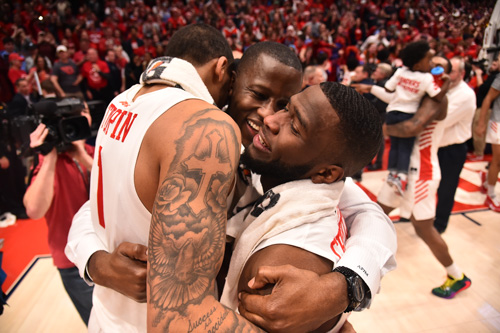 “We call it ‘Let Us Be Thankful.’ After every practice we’d break it down. We’d come together in a circle and someone took a turn in the middle and talked about what he’s thankful for that day.
“We call it ‘Let Us Be Thankful.’ After every practice we’d break it down. We’d come together in a circle and someone took a turn in the middle and talked about what he’s thankful for that day.
“But this time, we all did it. It was basically a kind of a farewell and a reminder of everything we’ve done.”
When it was his turn, Greer said he told everyone, “Look, I’m from the South Side of Chicago and having an experience like this. That’s something we only dream of.
“I told them how this was the first time I was ever on what was a real team, where there was camaraderie and love for each other and where we won, too.
“I am going to remember this season, this team and everything that happened here for the rest of my life.”
“I said, ‘I am going to remember this season, this team and everything that happened here for the rest of my life.’”
For so many reasons, the rest of us will, too.
Tom Archdeacon ’72 is a longtime columnist for the Dayton Daily News. All photos by Erik Schelkun/Elsestar Images.
GRANT, TOPPIN -- THE BEST
Anthony Grant and Obi Toppin this year were, respectively, the best coach and the best player in college basketball. Almost everybody says so.
Grant won all of the five major coach of the year awards:
* Associated Press
* Naismith
* National Association of Basketball Coaches
* United States Basketball Writers Association
* The Sporting News
Redshirt sophomore forward Toppin, who has declared for the NBA draft, took five of the six major player of the year awards. The one he did not take was that given by The Sporting News. The publication did, however, name him a First Team All-American. He is UD’s first consensus First Team All-American.
His player of the year awards:
* Associated Press
* Naismith
* National Association of Basketball Coaches
* United States Basketball Writers Association
* Wooden
A-10 HONORS TO PLAYERS, COACHES
* Redshirt sophomore forward Obi Toppin was named the Atlantic 10 Player of the Year, the first men’s basketball player in school history to receive that award.
* Coach Anthony Grant was voted Coach of the Year.
* Junior guard Jalen Crutcher joined Toppin on the All-Conference First Team.
* Senior guard Trey Landers was named to the All-Conference Third Team.
* Forward Ryan Mikesell, a graduate student, was named to the A-10 All-Academic Team.